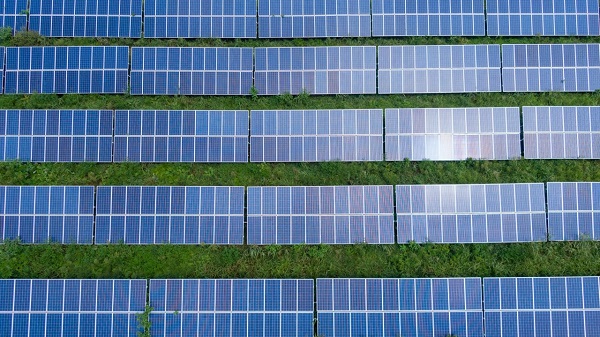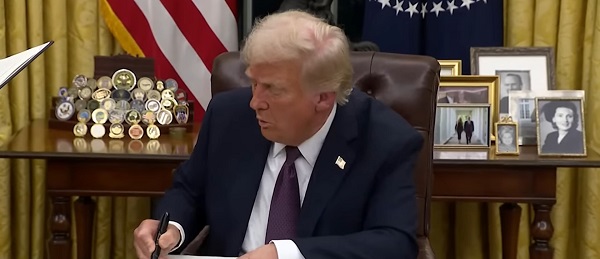Energy
Solar’s Dirty Secret: Expensive and Unfit for the Grid

From the Frontier Centre for Public Policy
By Ian Madsen
To store twelve hours worth of the 1.6 TW total installed global solar power capacity would cost about 12.9 trillion Canadian dollars
Solar energy’s promise of a green, abundant future is captivating—but beneath the shiny panels lies a story of unreliability, hidden costs, and grid instability.
Green enthusiasts endorse solar energy to reduce carbon dioxide (CO2) emissions from traditional energy sources such as coal, oil, and natural gas. The source of solar power, the sun, is free, abundant, and always available somewhere. However, these claims are misleading. Solar energy is costly and unreliable in ways its proponents commonly disguise. If adopted extensively, solar energy will generally make energy and electric power grids more unreliable and expensive.
The solar industry has burgeoned remarkably, with an estimated average compound annual growth rate (CAGR) of about 39 percent from 2021 to 2024. Earlier this century, the growth rate was even faster. As a result, global installed solar capacity has reached 1.6 terawatts (TW), according to the U.S. Energy Department. This capacity is theoretically sufficient to power a billion homes at 1.5 kilowatts per home. However, the term “theoretically” poses a significant challenge. Solar power, without affordable energy storage solutions, is only available during daylight hours.
The minimum amount of storage required to make global solar power truly “dispatchable”—i.e., independent of other backup energy sources—would be twelve hours of storage. Options include batteries, pumped hydro, compressed air, or other technologies. Since batteries are today’s standard method, the following calculation estimates the cost of the minimum amount of battery storage to ensure reliable solar power.
Twelve hours per day multiplied by 1.6 terawatts and dividing the result by one kilowatt-hour (kWh), we arrive at a final requirement of 19.2 billion kWh of storage. According to a meta-study by the National Renewable Energy Lab, the utility-grade cost of battery storage is C$670.99 per kWh.
To store twelve hours worth of the 1.6 TW total installed global solar power capacity would cost about 12.9 trillion Canadian dollars; a safer twenty-four hours’ storage would be double that. Total storage available in 2023 was, the International Energy Agency notes, approximately two hundred and sixty gigawatts (GW) of power – a tiny fraction of power production of 3.2 million GW in 2022, using figures from Statista.
No firms or governments can have the necessary storage to make solar viable even if the entire globe was involved, as the total global GDP was about C$148 trillion in 2023, according to World Bank figures. That is not solar’s only problem. The most harmful effect is how it undermines power grids. The misleading, ‘levelized’ near-zero cost undercuts traditional, reliable on-demand energy sources such as coal, natural gas and nuclear power.
Importantly, high solar and wind power output can make prices turn negative, as an Institute for Energy Research article noted, but can swiftly revert to high prices when winds calm or the sun sets, as the fixed costs of traditional power plants are spread over lower production. Baseload traditional energy sources are essential because the frequent unavailability of renewables can be dangerous. Consequently, overall costs for customers are higher when renewables are included in the energy mix. Solar mandates in California made its power supply wildly erratic.
Without affordable energy storage, solar is a seductive illusion; its unchecked adoption risks turning power grids into unreliable, costly experiments at the expense of energy stability.
Ian Madsen is the Senior Policy Analyst at the Frontier Centre for Public Policy.
Alberta
COWBOY UP! Pierre Poilievre Promises to Fight for Oil and Gas, a Stronger Military and the Interests of Western Canada

Fr0m Energy Now
As Calgarians take a break from the incessant news of tariff threat deadlines and global economic challenges to celebrate the annual Stampede, Conservative party leader Pierre Poilievre gave them even more to celebrate.
Poilievre returned to Calgary, his hometown, to outline his plan to amplify the legitimate demands of Western Canada and not only fight for oil and gas, but also fight for the interests of farmers, for low taxes, for decentralization, a stronger military and a smaller federal government.
Speaking at the annual Conservative party BBQ at Heritage Park in Calgary (a place Poilievre often visited on school trips growing up), he was reminded of the challenges his family experienced during the years when Trudeau senior was Prime Minister and the disastrous effect of his economic policies.
“I was born in ’79,” Poilievre said. “and only a few years later, Pierre Elliott Trudeau would attack our province with the National Energy Program. There are still a few that remember it. At the same time, he hammered the entire country with money printing deficits that gave us the worst inflation and interest rates in our history. Our family actually lost our home, and we had to scrimp and save and get help from extended family in order to get our little place in Shaughnessy, which my mother still lives in.”
This very personal story resonated with many in the crowd who are now experiencing an affordability crisis that leaves families struggling and young adults unable to afford their first house or condo. Poilievre said that the experience was a powerful motivator for his entry into politics. He wasted no time in proposing a solution – build alliances with other provinces with mutual interests, and he emphasized the importance of advocating for provincial needs.
“Let’s build an alliance with British Columbians who want to ship liquefied natural gas out of the Pacific Coast to Asia, and with Saskatchewanians, Newfoundlanders and Labradorians who want to develop their oil and gas and aren’t interested in having anyone in Ottawa cap how much they can produce. Let’s build alliances with Manitobans who want to ship oil in the port of Churchill… with Quebec and other provinces that want to decentralize our country and get Ottawa out of our business so that provinces and people can make their own decisions.”
Poilievre heavily criticized the federal government’s spending and policies of the last decade, including the increase in government costs, and he highlighted the negative impact of those policies on economic stability and warned of the dangers of high inflation and debt. He advocated strongly for a free-market economy, advocating for less government intervention, where businesses compete to impress customers rather than impress politicians. He also addressed the decade-long practice of blocking and then subsidizing certain industries. Poilievre referred to a famous quote from Ronald Reagan as the modus operandi of the current federal regime.
“The Government’s view of the economy could be summed up in a few short phrases. If anything moves, tax it. If it keeps moving, regulate it. And if it stops moving, subsidize it.”
The practice of blocking and then subsidizing is merely a ploy to grab power, according to Poilievre, making industry far too reliant on government control.
“By blocking you from doing something and then making you ask the government to help you do it, it makes you reliant. It puts them at the center of all power, and that is their mission…a full government takeover of our economy. There’s a core difference between an economy controlled by the government and one controlled by the free market. Businesses have to clamour to please politicians and bureaucrats. In a free market (which we favour), businesses clamour to impress customers. The idea is to put people in charge of their economic lives by letting them have free exchange of work for wages, product for payment and investment for interest.”
Poilievre also said he plans to oppose any ban on gas-powered vehicles, saying, “You should be in the driver’s seat and have the freedom to decide.” This is in reference to the Trudeau-era plan to ban the sale of gas-powered cars by 2035, which the Carney government has said they have no intention to change, even though automakers are indicating that the targets cannot be met. He also intends to oppose the Industrial Carbon tax, Bill C-69 the Impact Assessment Act, Bill C-48 the Oil tanker ban, the proposed emissions cap which will cap energy production, as well as the single-use plastics ban and Bill C-11, also known as the Online Streaming Act and the proposed “Online Harms Act,” also known as Bill C-63. Poilievre closed with rallying thoughts that had a distinctive Western flavour.
“Fighting for these values is never easy. Change, as we’ve seen, is not easy. Nothing worth doing is easy… Making Alberta was hard. Making Canada, the country we love, was even harder. But we don’t back down, and we don’t run away. When things get hard, we dust ourselves off, we get back in the saddle, and we gallop forward to the fight.”
Cowboy up, Mr. Poilievre.
Maureen McCall is an energy professional who writes on issues affecting the energy industry.
Alberta
Alberta and Ontario sign agreements to drive oil and gas pipelines, energy corridors, and repeal investment blocking federal policies

Alberta-Ontario MOUs fuel more pipelines and trade
Alberta Premier Danielle Smith and Ontario Premier Doug Ford have signed two memorandums of understanding (MOUs) during Premier Ford’s visit to the Calgary Stampede, outlining their commitment to strengthen interprovincial trade, drive major infrastructure development, and grow Canada’s global competitiveness by building new pipelines, rail lines and other energy and trade infrastructure.
The two provinces agree on the need for the federal government to address the underlying conditions that have harmed the energy industry in Canada. This includes significantly amending or repealing the Impact Assessment Act, as well as repealing the Oil Tanker Moratorium Act, Clean Electricity Regulations, the Oil and Gas Sector Greenhouse Gas Emissions Cap, and all other federal initiatives that discriminately impact the energy sector, as well as sectors such as mining and manufacturing. Taking action will ensure Alberta and Ontario can attract the investment and project partners needed to get shovels in the ground, grow industries and create jobs.
The first MOU focuses on developing strategic trade corridors and energy infrastructure to connect Alberta and Ontario’s oil, gas and critical minerals to global markets. This includes support for new oil and gas pipeline projects, enhanced rail and port infrastructure at sites in James Bay and southern Ontario, as well as end-to-end supply chain development for refining and processing of Alberta’s energy exports. The two provinces will also collaborate on nuclear energy development to help meet growing electricity demands while ensuring reliable and affordable power.
The second MOU outlines Alberta’s commitment to explore prioritizing made-in-Canada vehicle purchases for its government fleet. It also includes a joint commitment to reduce barriers and improve the interprovincial trade of liquor products.
“Alberta and Ontario are joining forces to get shovels in the ground and resources to market. These MOUs are about building pipelines and boosting trade that connects Canadian energy and products to the world, while advocating for the right conditions to get it done. Government must get out of the way, partner with industry and support the projects this country needs to grow. I look forward to working with Premier Doug Ford to unleash the full potential of our economy and build the future that people across Alberta and across the country have been waiting far too long for.”
“In the face of President Trump’s tariffs and ongoing economic uncertainty, Canadians need to work together to build the infrastructure that will diversify our trading partners and end our dependence on the United States. By building pipelines, rail lines and the energy and trade infrastructure that connects our country, we will build a more competitive, more resilient and more self-reliant economy and country. Together, we are building the infrastructure we need to protect Canada, our workers, businesses and communities. Let’s build Canada.”
These agreements build on Alberta and Ontario’s shared commitment to free enterprise, economic growth and nation-building. The provinces will continue engaging with Indigenous partners, industry and other governments to move key projects forward.
“Never before has it been more important for Canada to unite on developing energy infrastructure. Alberta’s oil, natural gas, and know-how will allow Canada to be an energy superpower and that will make all Canadians more prosperous. To do so, we need to continue these important energy infrastructure discussions and have more agreements like this one with Ontario.”
“These MOUs with Ontario build on the work Alberta has already done with Saskatchewan, Manitoba, Northwest Territories and the Port of Prince Rupert. We’re proving that by working together, we can get pipelines built, open new rail and port routes, and break down the barriers that hold back opportunities in Canada.”
“Canada’s economy has an opportunity to become stronger thanks to leadership and steps taken by provincial governments like Alberta and Ontario. Removing interprovincial trade barriers, increasing labour mobility and attracting investment are absolutely crucial to Canada’s future economic prosperity.”
Together, Alberta and Ontario are demonstrating the shared benefits and opportunities that result from collaborative partnerships, and what it takes to keep Canada competitive in a changing world.
Quick facts
- Steering committees with Alberta and Ontario government officials will be struck to facilitate work and cooperation under the agreements.
- Alberta and Ontario will work collaboratively to launch a preliminary joint feasibility study in 2025 to help move private sector led investments in rail, pipeline(s) and port(s) projects forward.
- These latest agreements follow an earlier MOU Premiers Danielle Smith and Doug Ford signed on June 1, 2025, to open up trade between the provinces and advance shared priorities within the Canadian federation.
Related information
-

 Daily Caller2 days ago
Daily Caller2 days agoTrump’s One Big Beautiful Bill Resets The Energy Policy Playing Field
-

 Alberta8 hours ago
Alberta8 hours agoCOWBOY UP! Pierre Poilievre Promises to Fight for Oil and Gas, a Stronger Military and the Interests of Western Canada
-

 Alberta1 day ago
Alberta1 day agoAlberta Next: Immigration
-

 Business2 days ago
Business2 days agoThe Digital Services Tax Q&A: “It was going to be complicated and messy”
-

 International2 days ago
International2 days agoElon Musk forms America Party after split with Trump
-

 Carbon Tax2 days ago
Carbon Tax2 days agoCanada’s Carbon Tax Is A Disaster For Our Economy And Oil Industry
-

 Disaster2 days ago
Disaster2 days agoTexas flood kills 43 including children at Christian camp
-

 Alberta8 hours ago
Alberta8 hours agoAlberta and Ontario sign agreements to drive oil and gas pipelines, energy corridors, and repeal investment blocking federal policies



